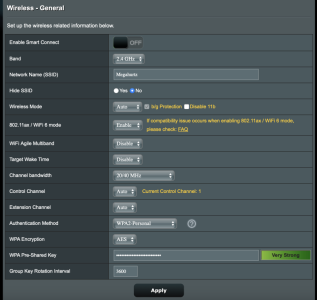I just upgraded to a GT-AX6000 and am pretty pleased with it's performance, but I had a few questions I want to throw out and get some feedback on.
1. What speed should I be expecting from the 2.4gig band? I never really checked it on my previous router, but on the new setup I'm getting around 120-150Mbit. That strikes me as quite slow!
2. I've always read that turning on any of the Ai Protect functions has a dramatic impact on throughput. I did turn it on and the router's built in speed test was still maxing out my connection at 1.4Gbit. However actual speed tests from AX devices connected to it would get more like 600-700 Mbit. I thought there was something wrong with my wifi settings, but disabling Ai Protect get my wireless client back to testing at 1.4gig. So it clearly does seem that Ai Protect has a severe performance penalty, but why doesn't it affect the built in speed test too?
3. My new router was a refurb from Amazon that came in a plain brown cardboard box sealed with Asus tape. SSH'ing into it and running "wl country" tells me that the country code is set for Canada. Is that typical for North American Asus routers? Any limitations on me using it in the US?
4. What is the preferred transmit power setting for the wifi radios? I think they both defaulted to max.
1. What speed should I be expecting from the 2.4gig band? I never really checked it on my previous router, but on the new setup I'm getting around 120-150Mbit. That strikes me as quite slow!
2. I've always read that turning on any of the Ai Protect functions has a dramatic impact on throughput. I did turn it on and the router's built in speed test was still maxing out my connection at 1.4Gbit. However actual speed tests from AX devices connected to it would get more like 600-700 Mbit. I thought there was something wrong with my wifi settings, but disabling Ai Protect get my wireless client back to testing at 1.4gig. So it clearly does seem that Ai Protect has a severe performance penalty, but why doesn't it affect the built in speed test too?
3. My new router was a refurb from Amazon that came in a plain brown cardboard box sealed with Asus tape. SSH'ing into it and running "wl country" tells me that the country code is set for Canada. Is that typical for North American Asus routers? Any limitations on me using it in the US?
4. What is the preferred transmit power setting for the wifi radios? I think they both defaulted to max.
Last edited:


